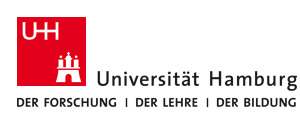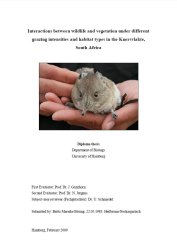
|

Department of Biology Institute of Plant Science and Microbiology |
| Division BEE > BEE Press: Theses > 10.7809/thesis.diplom.001 |
|
Diplom thesis Open Access Interactions between wildlife and vegetation under different grazing intensities and habitat types in the Knersvlakte, South Africa
Britta M. Bösing Language: English Published: February 2009 First published online: 2013-02-15 DOI: 10.7809/thesis.diplom.001
Author contact: Keywords: biodiversity; domestic livestock; exclosure; live trapping; Macroscelides proboscideus; Namaqualand; nature conservation; Rhabdomys pumilio; seed predation; species richness; vegetation cover English abstract: In order to assist the management of the Knersvlakte Conservation Area with future management decisions, the interactions between wildlife and vegetation under different livestock grazing intensities and habitat types in the Knersvlakte, South Africa were investigated. The Knersvlakte belongs to the Succulent Karoo, which is a biodiversity hotspot due to its extraordinary plant species richness. A total of 22 plots were selected according to two grazing intensities (moderate and intensive) and two major habitat types (quartz fields, loamy soils) were studied. On each of these plots, small mammal live trapping (90 traps during 4 nights) was carried out and the cover of different vegetation layers was estimated. Moreover, seed predation experiments with different exclosure types were carried out on a total of 8 plots to compare the activity of arthropods, small mammals and birds under different grazing intensities and in different habitats. In order to detect potentially confounding effects, abiotic factors including weather, moon, and day of year were determined from August to November 2007. In total, 140 small mammal individuals from 10 species were caught during 7,920 trap nights. The small mammal species composition on intensively grazed fields was a subset of that on moderately grazed fields. The most abundant species on loam fields were Macroscelides proboscideus and Rhabdomys pumilio and on quartz fields Macroscelides proboscideus and Gerbillurus paeba. Generalised linear models revealed that habitat type had the strongest influence on abundance and diversity of small mammals. Vegetation cover only had an indirect influence on abundance, diversity and the body condition of small mammals via the habitat type. A high grazing intensity negatively influenced the seed predation of small mammals and arthropods (mainly ants and termites), which were the most important seed predators and consequently the most important analysed animal groups for vegetation dynamics. A germination experiment with dung of indigenous herbivores implicates that antelopes are more abundant on moderately grazed fields than on intensively grazed fields. Weather, moon, and day of year only influenced the seed predation of arthropods and small mammals. Overall, a high grazing intensity had a negative influence on the diversity and activity of small mammals, indigenous herbivores and the activity of arthropods. From a conservation point of view, it would thus be desirable to reduce the livestock grazing intensity in the future Conservation Area
Suggested citation: |
| Imprint / last update: 2023-01-13 by: Gerhard Muche | search |
